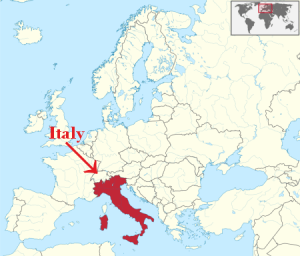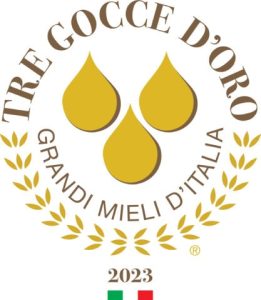What honey can one find in Italy? How is Italian honey? Sweet as the country!
With its Mediterranean weather there is no wonder Italy has lots of melliferous plants and beekeepers love their job. 
There are more than 300 types of honey on the Italian market and the most important ones come from the following plants: Acacia, Citrus fruits, Tree-of-heaven (Ailanthus altissima), Asphodelus, Artichoke thistle (Cynara cardunculus), Chestnut, Sweet cherry, Rapeseed, Strawberry tree, Coriander, Common Ivy, Alfalfa, Tree Heather, Winter heath (Erica carnea), Eucalyptus, Sun Flower, False Indigo Bush (Indaco bastardo), Lampone (Rubus idaeus), French Lavender (Lavanda selvatica), Marruca (Paliurus spina-christi Mill.), Honeydew (Melata di bosco), Fir tree, Multifloral, Multifloral from the Alps Mountains, Rhododendrons, Rovo (Rubus ulmifolius), Spanish sainfoin (Hedysarum coronarium L.), Dandelion , Linden, Thyme (Timo arbustivo), Clover.
 Perhaps the most important honey competition in Italy is “TRE GOCCE D’ORO – GRANDI MIELI D’ITALIA”, (Three Drops of Gold) organized by L’Osservatorio Nazionale Miele. In 2023 it reached its 43rd edition.
Perhaps the most important honey competition in Italy is “TRE GOCCE D’ORO – GRANDI MIELI D’ITALIA”, (Three Drops of Gold) organized by L’Osservatorio Nazionale Miele. In 2023 it reached its 43rd edition.
The contest is addressed only to Italian beekeepers, either commercials or home-use only and in the latest years there were more than 450 beekeepers and 1100 participating honeys per edition.
The first prize receives the Tre Gocce D’Orro Award (Three drops of gold); the second prize received Due Gocce D’Orro (Two drops of gold) and the third prize receives Una Goccia D’Orro (One drop of gold). In 2022 there were 17 Tre Gocce, 201 Due Gocce and 288 Una Goccia awards. That’s 506 awards.
The deadline for receiving the samples is 25th of August and the awarding will take place in Castel San Pietro, on Sunday 17 September 2023.
Here you can see the categories accepted.
At London International Honey Awards, Italy won 4 awards, one of them with the amazing Miele Italiano Acacia, by Apicoltura Luca Finocchio Di Luca Finocchio. (more on the best honey in 2023 at LIHA)
There is good news for Italy! Sweet days will come!
Astute Analytica announced on 25th of August that the Italian honey market value in 2022 was $103.8 million and is intended to attain $179.8 million by 2031, growing at a CAGR of 6.3% during the forecast period from 2023 to 2031.
There is a big campaign of promoting honey in Italy if we think that about half a kilo of honey is consumed per person per year, below the European average of 600 grams, but one third compared to Germany.
And even if there is not an official campaign, people’s tendency to eat healthy, to replace sugar with its healthy alternative, honey, and to use it as medicine will indeed raise honey production despite challenging weather.
What honey can we find in Italy?
ACACIA
· aka Black locust
· Robinia pseudoacacia
· harvested in March – April,
· in the following regions: Piemonte, Lombardia,Liguria, Friuli, Veneto, Emilia-Romagna, Toscana, Marche, Lazio, Calabria.
· production varies from 15 to 25 kg/hive.
Acacia honey is made of false acacia!
AGRUMI
· Citrus spp.
· Harvested from March to April
· found in Basilicata, Calabria, Puglia, Sicilia, Sardegna.
· Production from 10 to 30 kg/hive
· aka Sweetvetch, Sweet Broom or French Honeysuckle
· Hedysarum coronarium
· harvested fromApril to June
· Found in Toscana, Abruzzo, Basilicata, Molise, Campania, Calabria, Sicilia,
· production of 15-30 kg/hive
TIGLIO
· aka linden or lime
· Tilia spp.
· Harvested from March to July
· found in Valle d’Aosta, Piemonte, Lombardia, Friuli, Veneto, Emilia-Romagna, Trentino-Alto Adige, Toscana, Marche, Lazio
· production of 10 to 20kg/hive
CASTAGNO
· aka Chestnut
· Castanea sativa
· harvested in June and July
· produced in Valle d’Aosta, Piemonte, Lombardia, Liguria, t Friuli, Veneto, Trentino, Emilia-Romagna, Toscana, Marche, Lazio, Abruzzo, Campania, Basilicata, Calabria, Sicilia.
· production from 10 to 20 kg/hive
EUCALIPTO
· Eucalyptus
· Eucalyptus camaldulensis
· harvested from July till August
· in Lazio, Basilicata, Calabria, Sicilia, Sardegna
· production of 10-15 kg/hive
CORIANDOLO
· Coriander
· Coriondrum sotivum
· harvested from March to July
· In Emilia-Romagna, Marche, Basilicata, Campania, Molise, Puglia
· production of 10 to 30 kg/hive
Coriander honey – one of the best cure of constipation and flatulence
The most important honey producers in Italy are:
• Api Brescia Societa’ Cooperativa
• Apicoltura Bonetti
• Apicoltura Mieldoro
• Azienda Agraria Bevilacqua
• Azienda Agricola Bio Bonizio
• Barkman Honey LLC
• Capilano Honey Ltd.
• Dabur India Ltd
• Fiorillo SRL
• Martin Miele
• Nanako Goods
• Nicolas srl
• Podere Castello Di Uzzano
• Conapi
• Other Prominent Players
US Bee Scientists work with Italians to improve the genetic variability of their bee populations.
According to a Washington State University research team, one of the causes of high bee mortality in the United States is the depletion of genetic variability of honey bees. This has left them short of genetic traits that could help them resist varroa, a common disease among bees.
Susan Cobey, a geneticist in WSU’s entomology department and queen bee breeder, explains why: “Honey bees are not native to the American continent, we brought them here, but in 1922 the U.S. closed its borders to bee imports to prevent the spread of Acarapis woodi (the small trachea mite that did so much damage a few years earlier in the U.K.) and since then our bee populations have been interbreeding with each other.”
Picture source: Concorso Fotografico Oss. Miele.
References and further readings:
italy-honey-market-is-set-to-rise-at-a-revenue-of-us-179-8-million-by-2031-astute-analytica;
astuteanalytica.com/industry-report/italy-honey-market




